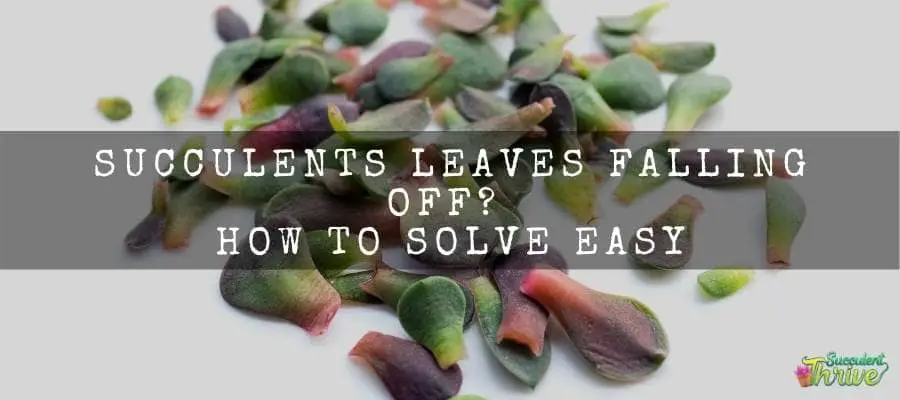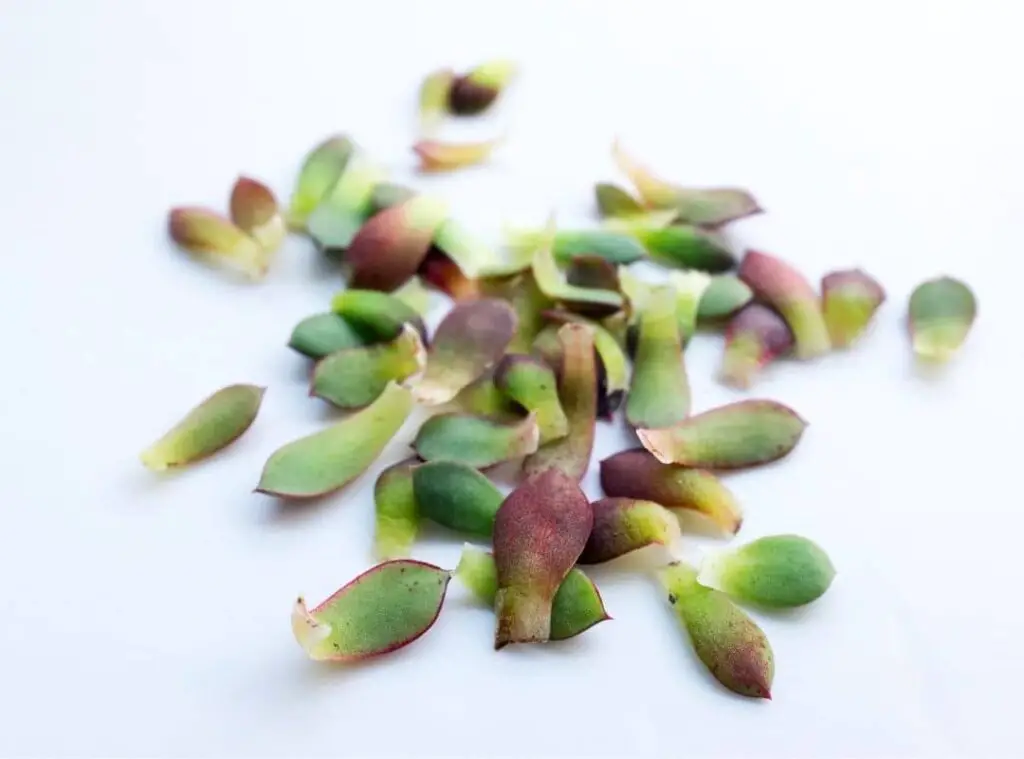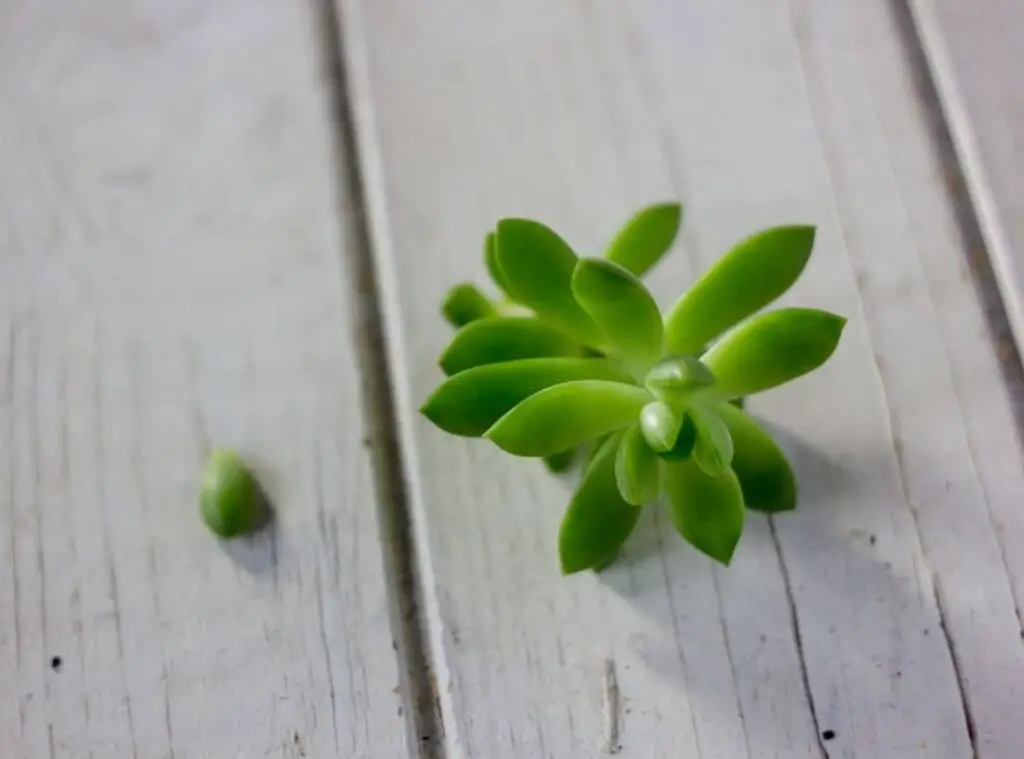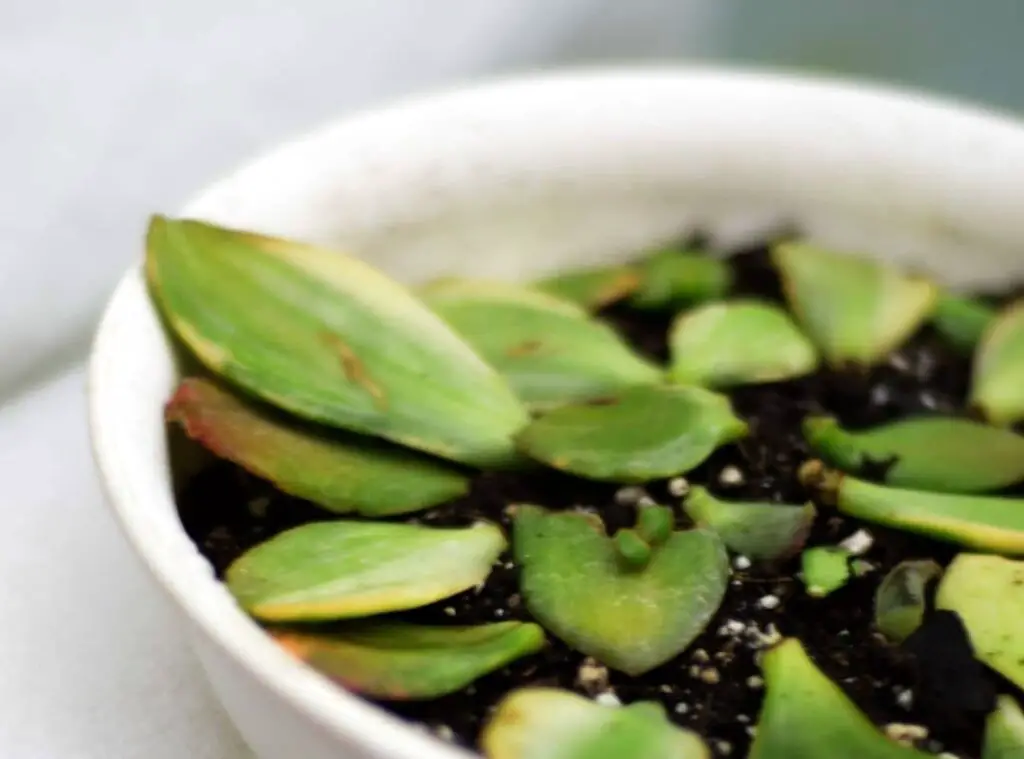It can be heartbreaking to watch your beautiful succulent plants shedding leaves out of nowhere. While this may indicate that your plant is stressed or unhealthy, the exact cause is unclear. However, if your succulent leaves fall off, you should not take this lightly or ignore it. It’s essential to check in on your plant and see what’s causing the “succulents leaves falling” off.

What to do when Succulents Leaves Falling Off?
When the leaves of your succulent plant fall off, let those fallen leaves dry for three days. This is to prepare the fallen leaves for propagation. Propagation is the procedure of growing succulents or from a variety of parts from plants.
Here’s a guide on how to propagate the fallen leaves of your succulent.
- After letting the fallen leaves of your succulents dry for two to three days put them on top of a surface of cactus soil. You can use a normal pot, a flat surface like a tray, or anything you like. The purpose is to put the dried-out leaves on cactus soil.
- Spray a bit of water every two days.
- New roots and rosettes will begin to develop at the bottom of the leaf after around three weeks!
- After about a month has passed, plant the fallen leaf with recently developed roots in the cactus soil with a rosette facing upwards. There you go! You have a new succulent plant now!
How do prevent the succulent leaves from falling off?
Since there could be a few reasons that could cause your Succulent’s Leaves Falling Off there are a few things you could do to prevent your plant from losing its leaves as well. Let’s go through it one by one.
Overwatering
Overwatering can be one of the reasons that the leaves of your succulent leaves fall. When you add excess water to your plants, the leaves get swollen. They become tender and mushy and they fall off in the end.
Prevention
In order to avoid this, until the top layer of the soil feels dry, retain from watering the plant. Ensure that the potting soil is depleting and that the succulent plant roots do not remain wet for too long.
Warm climate
Under extreme temperatures, the leaves of your succulent plant may fall off. Under periods of extreme heat or dry spells, succulents react by shedding their leaves to help store energy and keep up with their stock of water. Some measures can be taken to reduce stress in your plant, as this is a natural reaction in nature.
Prevention
Shift the plant away from extreme sun exposure into a shadier spot during a heatwave or a dry period. Under these circumstances, the plant will also need to be watered more frequently. Water the succulent plant when appropriate or when the first inch of the soil layer feels parched to the touch.
Lack of sunlight
Succulents, if held in low light conditions for too long, will begin to shed their leaves. If it grows tall and stretched out, you will know that your plant has been under too much shade for too long. Also, succulents that don’t get enough sunlight will start growing towards a source of light. So if it seems like your succulent plant is growing sideways to get closer to a window, that’s another indicator that the problem is a lack of light.
Prevention
Fortunately, this problem is very easy to solve! All you have to do is place your plant elsewhere that is more exposed to sunlight or move it under a grow light. But before placing it outside and exposing it to the blazing light of the sun, ensure you first help the plant adapt to it!

Do succulent leaves grow back after falling off?
In contrast to other plants, new succulent leaves can’t develop from elsewhere other than their head. To be exact, leaves can’t regrow from the base or center of the plant. When succulent leaves fall, another one can’t fill in its place. Hang tight! However, this doesn’t mean that all hope is lost for your precious succulent!
At times, branches or second heads supplant the uncovered spots on the stem. Subsequently, the boldness rapidly vanishes as another plant develops. As the plant keeps on developing from the head in different cases, the base gradually tops off. As time passes by, your succulent will get more full, and you’ll scarcely see the vacant spots.
Why did all the leaves fall off my succulent?
Temperature
Since most succulents are adjusted to hot, bone-dry regions were drawn out; times of warmth are the standard; they react by dropping leaves when distressed by heat or a dry spell. Though this is moderately typical, keeping succulents in the shade when temperatures take off will help forestall this.
Watch them intently: on the off chance that they look shriveled or burned from the direct sunlight, move them or spot a shade material over them. Likewise, the contrary issue happens: succulents don’t handle freezes well, which may darken and scorch their leaves. Now and then, these will fall off, yet usually not until the plant develops new leaves to replace them, so fight the temptation to strip off these defensive dead leaves.
Lack of Light
Succulents need sufficient light, particularly as they are normally adjusted to zones with heaps of sun all year. They do great in brilliantly lit regions, and when in the absence of light, will turn yellow or light green and irregular, attempting to grow in the direction of the light. On the off chance that the issue isn’t revised, they will drop leaves or bite the dust in the end.
Low light isn’t the solitary issue – succulents that are moved to another region without acclimation or unexpectedly turned into a bright spot may get a burn from the sun on the side that hasn’t seen the sun for some time. Make changes gradually, and ensure that plants adjust before proceeding onward.
Watering issues
Succulents are known for requiring little water and keeping in mind that too little will make them wither and disable them to flourish, you should be cautious about over-watering them. Providing succulents with an extreme amount of water time and time again will inflate their leaves and, on the off chance that they don’t get a chance to dry out, cause the plant to die.
Stand by until the soil is totally dry and the leaves look somewhat limp prior to watering, at that point water completely, until you see streams emerging from the lower part of the pot. Redo the cycle. Continuously use pots with outflow openings for succulents.

Can you save a succulent with no leaves?
When a succulent stem loses all its leaves, it won’t develop back on it. You need to scale it back and propagate by the stem cells’ cuttings or have it revive from the bottom (Roots and the part of stem still in the soil).
Why are my succulent leaves falling off when I touch them?
On the off chance that the succulent leaves fall easily when you touch them or when the pot is shaken a little, this is an indication that you watered your succulent to an extreme.
How do you save a dying succulent?
Succulents (counting cacti) have countless interesting structures, sizes, and shadings that make them an ideal plant for practically any taste. An unexpected decrease in their wellbeing is typical because of water concerns yet periodically can be from diseases or pests. Saving dying succulents begins with sorting out which began their decay so you can cure the issue. Does your aloe or cactus look somewhat miserable? Fortunately, succulents are exceptionally strong and adaptable.
While the plant’s decline may have you somewhat terrified, as a rule, resuscitating succulents is very simple, and the plant will revive rapidly.
They are adjusted to living in specific and frequently unforgiving conditions. Most importantly, what kind of succulents do you own? Is it a tropical or a desert succulent? Considering watering is the typical reason for their rot, you ought to decide whether the plans have been over or underwatered.
In the event that the stem is mushy or decaying, it’s likely overwatered. On the off chance that the leaves are wrinkled, they require to be watered further. Try not to stress if there are dry or dying leaves at the base. This is ordinary as the plant creates new leaves. Also, you can move the plant Ensure the succulent is in a well-depleting soil. On the off chance, it’s in a container; it ought to have drainage holes or well-draining soil. Put a finger into the soil up to the subsequent knuckle.
In the event that the soil is soggy or cool, the plant is sufficient water. If it is overly moist, the plant is required to dry out and ought to presumably be removed from the current medium and repot in soil that’s dry.
Too much water commonly causes rot in succulents. They are known for drought resistance yet need water, similar to some other plants. Utilize a moisture meter to get it spot on. In the event that the plant’s medium is dehydrated because of disregard or carelessness, soak it in a bigger container of water to get the soil sodden. Proper water drain is the key. wait soil is completely dry until watering again.
Succulent care can be shifted outside in summertime in many environments. Nonetheless, they can get burned by the sun, frozen, or assaulted by bugs. In the event that you see bugs, utilize a natural horticultural soap to eliminate the vermin. In the event that your plant encountered a freeze, eliminate any fallen or mushy leaves. In the event that the leaves of your plant are burned, eliminate the most noticeably terrible leaves and make adjustments to the lighting of the succulent.
Most of the time, saving dying succulents is fairly basic. Give significant consideration after they experience an “occasion” that made their shortcoming. When in doubt, safeguard a decent leaf or stem section, and permit it to callus, at that point plant in cactus soil. This piece of the plant will take off rapidly, permitting you to protect the species.
Why are my succulent leaves curling down?
At the point when succulents’ leaves curl down, they may be experiencing any of the accompanying:
- Underwatering
- Overwatering
- not enough light
- An excessive amount of exposure to sunlight
- Any of these variables are inconvenient to the succulents’ general wellbeing.
What do I do when my succulents lose their leaves?
If the leaves of your plant are falling off, the first step would be to find what’s causing your succulent to lose leaves. If it’s overwatering or underwatering, when the first inch of the soil’s surface feels dry, douse the soil, and afterward let it dry completely. Make sure to repeat the same procedure since succulents like to have their soil drenched and later dry out prior to watering once more.

How do I know if my cactus is dying?
Discoloring cactus
Cacti will show a hint that isn’t normally its own. Depending upon where the issue is coming from, the color difference may begin at the top end of the stem fragments or from the soil’s base. Dying is ensured if quick actions aren’t taken.
Droopy leaves on cacti
The dying of the few leaf-bearing cacti (like epiphyllum) is motioned by descending pointing leaves that lack hardiness.
Soft segments around your cactus
The difference in color above might be joined by soft stem portions that seem swollen This additionally implies they can sever easily with negligible force applied. Take a stab at pulling a spine off. That is a withering cactus if you can pull off the specific leaves.
Instability in your cactus potting soil
You’ll notice this if the succulent is leaning to a side. Not bent – simply the entire plant inclining to a specific side. A perishing cactus is precarious in its potting mix and may seem like it’s going to tumble off – all things considered. It will tumble off on the off chance that you moved it, for a serious case—an indication of the absence of roots. Or on the other hand, the current ones might be excessively frail to uphold the plant appropriately. This is considering the plant pot perfectly.
Foul smells coming from your cactus plant
Unfortunately, that is genuinely downright terrible. A putrid smell implies a massive piece of the cacti is totally decaying, and there isn’t anything you can do to revive it. Basically, this means that it’s not in the process of dying but has already died at this point. The best anyone can hope for at this point is to discard your battling cactus plant and get another one.
How do I know if my succulent is dying?
Here are a few signs that would indicate your succulent is dying. On the off chance that the leaves of your plant are starting to look transparent and yellow and perceive wet or soft when touched, it’s probably water too much. An early indication of excessive watering is that the leaves of your plant will start to tumble off with simply a little knock.
If you start to see tiny dark spots on the stem or the leaves of your plant, the is being watered excessively and it could be hard to save it. The top leaves of your plant are beginning to curl down, get brittle, and shrive, at that point, it’s likely an ideal opportunity to provide more water. Sometimes succulent leaves fall off.
Though over or underwatering will be the most widely recognized issue succulents would be facing, there are a couple of more problems you may face. These may include: pest infestations, stretching out, internal contaminations, and much more. All these issues usually lead your plant to lose leaves at some point.
Read More How To Get Rid Of Aphids On Succulents | Full Guide
